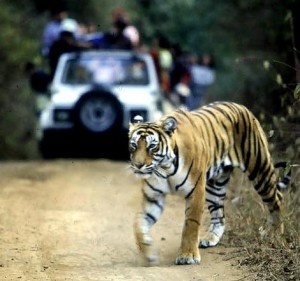 In a decision many are calling too harsh, the Supreme Court of India banned tourists from entering the core area of all tiger reserves in the country. With India being home to half of the global population of tigers, this means, India will be facing a major setback in number of travelers coming to the country to particularly see the tigers.
In a decision many are calling too harsh, the Supreme Court of India banned tourists from entering the core area of all tiger reserves in the country. With India being home to half of the global population of tigers, this means, India will be facing a major setback in number of travelers coming to the country to particularly see the tigers.
The court’s decision came after few of the tiger states failed to demarcate buffer zones and core areas even after the court ordered them to do so three months ago.
“Why tourism should be allowed in core areas of tiger reserves,” a bench of justices Swatanter Kumar and Ibrahim Kalifulla asked, while noting the tiger was on the verge of extinction.
The bench also warned of contempt proceedings and imposition of exemplary costs on states which failed to notify the buffer zones in their respective tiger reserves.
“We make it clear that till final directions are issued by this court, the core zones or core areas in the tiger reserves will not be used for tourism,” the bench said in its order.
The court slammed Andhra Pradesh, Arunachal Pradesh, Tamil Nadu, Bihar, Maharashtra and Jharkhand for failing to have notified the buffer zones despite earlier directions.
The SC also imposed a fine of Rs 10,000 on each defaulting state. However Arunanchal Pradesh and Jharkhand informed that they were ready with the notifications and would submit it to the court.
The court also strictly warned the defaulting states that if they were not able to submit the required documents within three weeks, the principle secretary of forest of the respective states will have to hand out a fine of Rs. 50,000 each.
The Supreme Court’s concern on the commercialization of tiger reserves of India has been ongoing for quite a few months now, with the court also ordering recently a 10 percent of all commercial activity fee to be handed over for conservation of the tiger area.
During the last hearing on July 10, the SC had granted two more weeks “as last opportunity” to states which had defaulted in notifying buffer zones around tiger reserves.
Rajasthan’s counsel had told the court during the last hearing that the state had already notified the zone.
On April 4, the apex court had asked Jharkhand, Rajasthan, Andhra Pradesh, Arunachal Pradesh, Uttar Pradesh, Bihar, Tamil Nadu, Karnataka and Maharashtra to notify the zones within three months.
Under Section 38(b) and Explanation 1 & 2 of the Wildlife (Protection) Act, 1972, the states have to notify the list of core and buffer areas of tiger reserves in their respective jurisdiction.
What is a buffer zone
Any national park is set up primarily to protect a particular species and its habitat. In order to do so, the core area is the innermost area where the animal lives in its own terms without any interference from humans. The only personels allowed in this area are the forest officers. This core area is where the species live a truly wild existence.
Next outer periphery of the core area is the buffer zone which is spread upto a distance of 10 km. Here human activities are allowed. Villagers and tribals living within the forest range are allowed to gather resources of the forest from this area. But the area is also frequented by the wild animals. If it basically this area where tourists too can come and observe wildlife.
The Indian tiger states have been not strictly demarcating the core and the buffer area allowing tourists to venture right into the den of the tiger. The Supreme court’s verdict therefore is to stop these kind of activites and allow the big cat to live the wild life it deserves.
Will the Restriction help?
Experts feel that the Court’s verdict is too harsh and it not only leads to loss of tourist revenue but also hinders conservation. Many feel that frequent tourist presence in forests ensures that the tigers are constantly spotted and kept safe. Forest guards too are more vigilant when tourists are around. Poachers are naturally discouraged to enter areas where chances of getting caught by tourists or officers are maximum.
With ban on tourism in core areas, the poachers might actually fearlessly venture into these areas. The forest departments of many states are already in dire need of more forest rangers, and officers. Without the indirect help they get from observant travellers, their task to check the safety of tigers becomes a lot more challenging.
Conservationists feel that the strict regulation of tiger zones and tourism are definitely the need of the hour, but banning tourism altogether is core areas is not the solution.
Presently most of the tiger reserves in the country are closed down for the monsoon season and will re-open in Spetember end or October. The SC has scheduled a hearing on the present case again, before October, so hopefully the decision will be re-evaluated.
More Related Stories,
Chopped Tiger Found in Maharashtra Tiger Reserve
Kawal Becomes India’s 42nd Tiger Reserve




2 thoughts on “Supreme Court Bans Tiger Tourism”